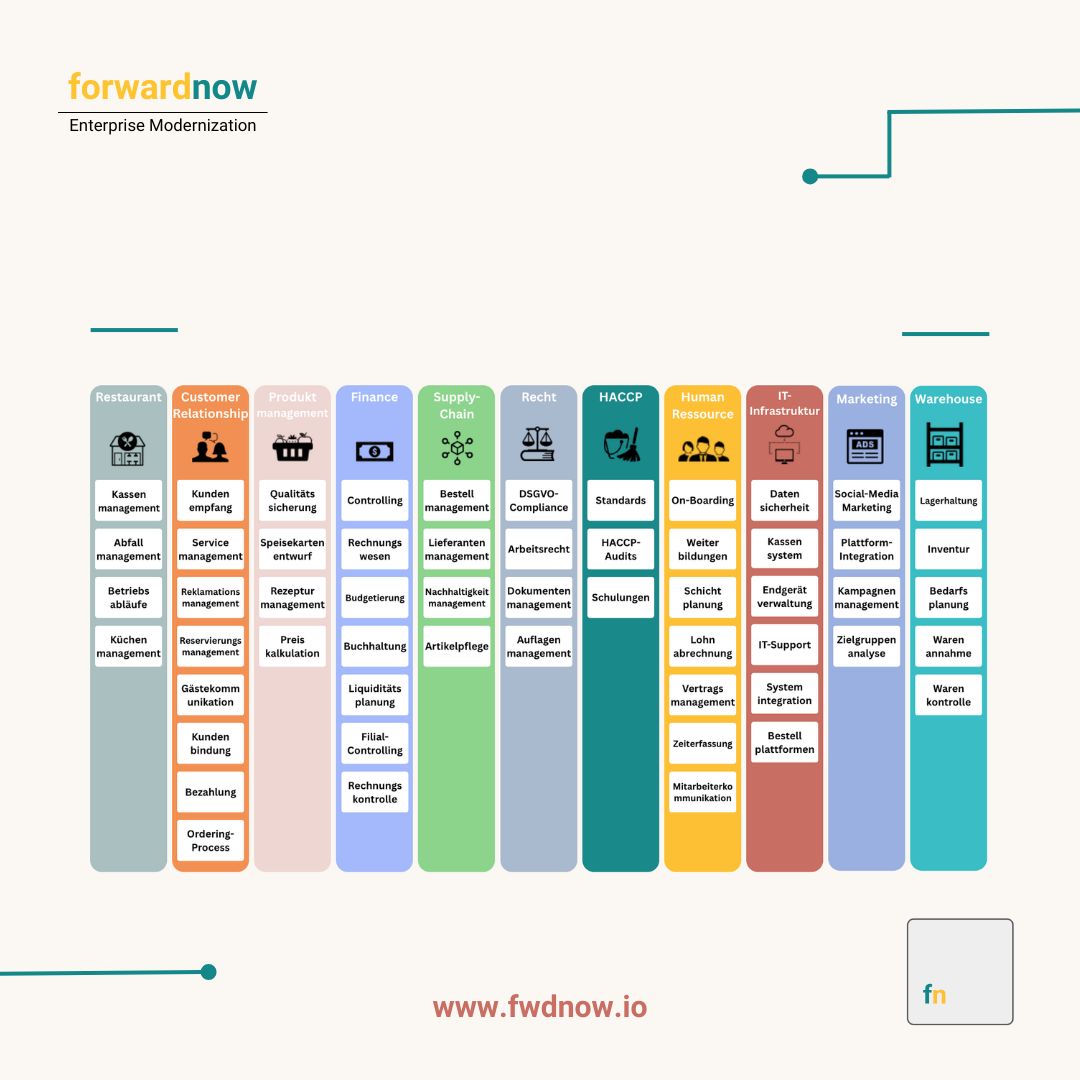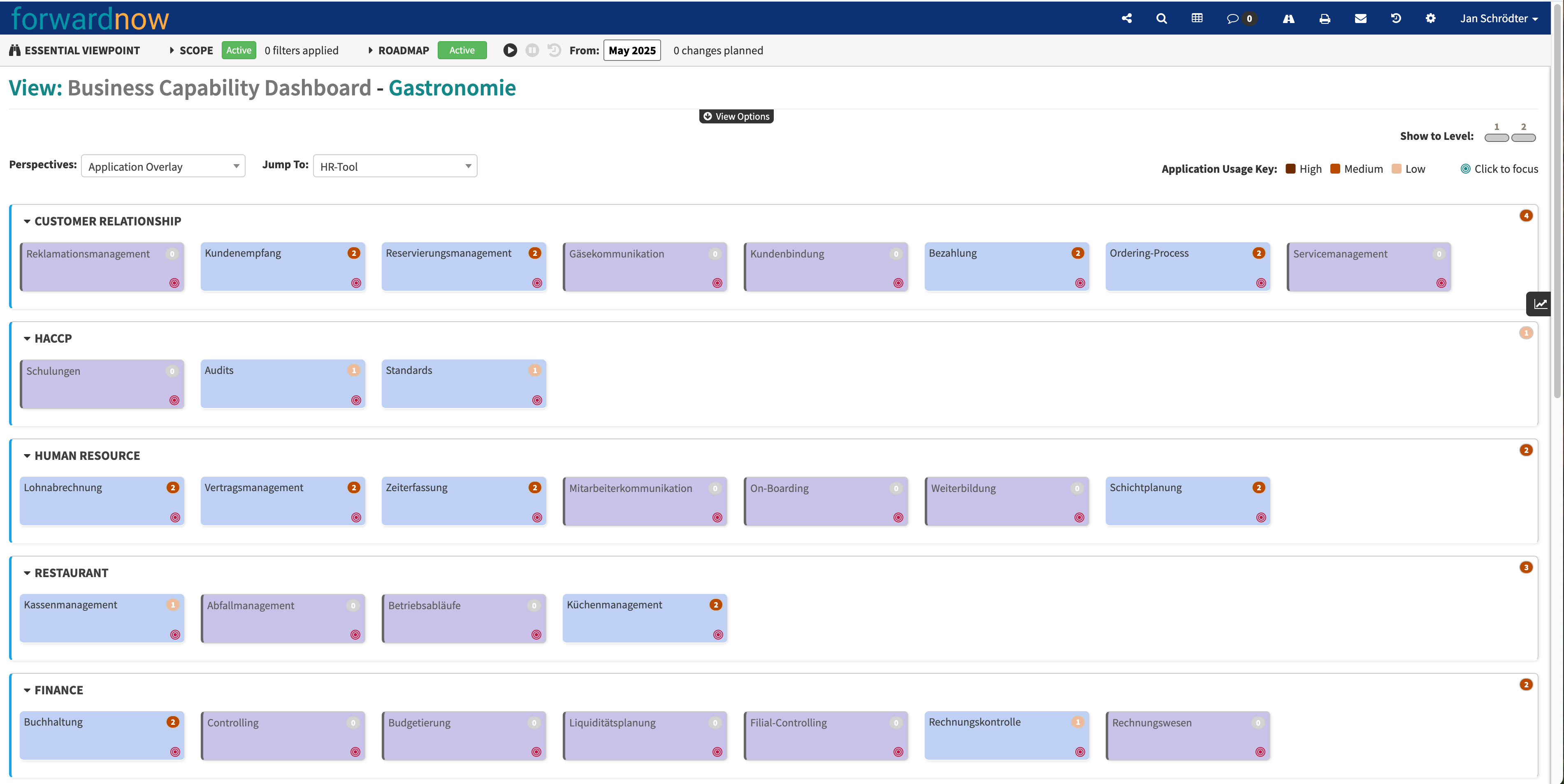From Fragmented Tools to Structured Strategy
How a Capability Model enables efficiency, transparency, and cost control in hospitality
Closing the digital gap. Why the hospitality industry needs to rethink now
Digitalization has profoundly changed sectors from industry to retail. For a long time, however, the hospitality industry was left behind. Complex operating processes, tight margins and a high proportion of manual activities meant that the digital transformation was often postponed or limited to individual areas such as POS systems or reservation platforms. But now there is no way around it. In view of rising costs, growing competitive pressure and a persistent shortage of staff, it is clear that catering businesses also need to rethink their internal processes. A holistic approach is becoming increasingly important. Especially in the context of enterprise architecture, i.e. the structured mapping of business and IT capabilities. What has long been standard in corporations is now also becoming relevant for restaurants. A systematic overview of processes, responsibilities and digital potential.
The strategic view of entrepreneurial competencies
A capability model describes the skills that a company needs to achieve its goals, regardless of how these are currently implemented organizationally or technically. It answers the question: What does the company need to be able to do in order to be successful? In contrast to process diagrams or organizational charts, a capability model does not focus on processes or roles, but on stable, business-relevant competencies. This makes it particularly valuable in times of change, such as growth, digitalization or restructuring. For the hospitality industry, this means that instead of looking at individual challenges in isolation, such as personnel planning, purchasing or customer loyalty, the model focuses on the big picture. It creates a common language between management, IT and operations and forms the basis for targeted decisions and strategic development.
 Illustration: Our capability model for system gastronomy
Illustration: Our capability model for system gastronomy
Growing complexity, increasing pressure and no structure
The hospitality industry is under intense pressure to change. A shortage of skilled workers, rising costs, legal requirements and growing guest expectations are coming together in an industry that is often still organized along analogue lines. At the same time, there is a growing need for more efficient processes, transparent management and digital networking. Many companies are responding with individual measures, such as new tools, new service providers or new systems. However, without an overarching structure, the effect remains limited. There is a lack of a unifying overall picture that shows where to really start.
How our capability model creates order
Individual tools or measures rarely solve fundamental problems. They combat symptoms, not causes. This is exactly where our capability model comes in. It creates structure where previously there was only operational complexity. The model divides the central capabilities of a catering business into clearly defined areas. Each of these capabilities describes what a company must be able to do, regardless of how it is currently implemented. This creates a holistic picture that helps to identify weaknesses, set priorities and make targeted improvements. The Capability Model replaces individual solutions with a well thought-out overall concept and thus becomes a strategic tool for sustainable further development. Our model can be seamlessly linked with common enterprise architecture tools such as ADOIT, LeanIX or Essential. This turns the structural analysis into a living management tool that can be integrated into existing transformation and IT landscapes.
 Illustration: Extract from Essential Cloud with business cabalities for system gastronomy*
Illustration: Extract from Essential Cloud with business cabalities for system gastronomy*
How successful application works in practice
The capability model is a tool for structured determination of the current situation: Which capabilities are already available in the company? Which ones are unclear or not sufficiently developed? Where do bottlenecks, duplicate structures or unnecessary complexities arise? In analyses and workshops, we evaluate the maturity level of individual capabilities together with the company. This creates a clear picture of strengths, weaknesses and potential. On this basis, measures can be prioritized in a targeted manner, for example to digitalize shift planning, to optimize the delivery of goods or to improve coordination between IT and operational business. This not only brings strategic benefits for management, but also relieves the burden on managers and staff on a day-to-day basis. When processes are clearly described, roles are clearly defined and systems are coordinated, managers and employees gain new freedom in operations.
A clear roadmap for the future to increase efficiency and reduce costs
In an industry with high competitive pressure and rising costs, it is crucial to make optimum use of your own resources. This is exactly where our Capability Model comes in. It creates transparency about a company’s actual processes and shows where these can be simplified, workflows automated and structures made more efficient. This leads to measurable results, such as less coordination effort, less operational friction, better controllability and, ultimately, lower costs. If you want to develop your organization in a targeted manner, you don’t need more tools, you need the right basis to make decisions efficiently and effectively. Request the complete overview now and arrange a 1:1 session in which we can discuss how you can specifically improve potential in your operational areas. If you would like to read more, take a look at our guide to introducing FinOps. We would love to hear from you about the challenges and plans you are currently facing in relation to FinOps and cost optimization.

Kai Herings
Senior consultant
Optimize alignment between IT and business with expert advice and clear strategies.
